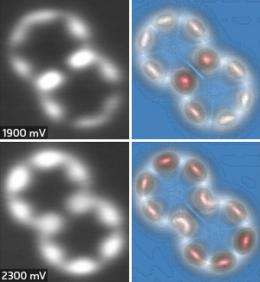Super benzene oligomers pave the way for new types of quantum computers

Scanning tunneling microscopy (STM) is routinely employed by physicists and chemists to capture atomic-scale images of molecules on surfaces. Now, an international team led by Christian Joachim and co-workers from the A*STAR Institute of Materials Research and Engineering has taken STM a step further: using it to identify the quantum states within 'super benzene' compounds using STM conductance measurements. Their results provide a roadmap for developing new types of quantum computers based on information localized inside molecular bonds.
To gain access to the quantum states of hexabenzocoronene (HBC)—a flat aromatic molecule made of interlocked benzene rings—the researchers deposited it onto a gold substrate. According to team member We-Hyo Soe, the weak electronic interaction between HBC and gold is crucial to measuring the system's 'differential conductance'—an instantaneous rate of current charge with voltage that can be directly linked to electron densities within certain quantum states.
After cooling to near-absolute zero temperatures, the team maneuvered its STM tip to a fixed location above the HBC target. Then, they scanned for differential conductance resonance signals at particular voltages. After detecting these voltages, they mapped out the electron density around the entire HBC framework using STM. This technique provided real-space pictures of the compound's molecular orbitals—quantized states that control chemical bonding.
When Joachim and co-workers tried mapping a molecule containing two HBC units, a dimer, they noticed something puzzling. They detected two quantum states from STM measurements taken near the dimer's middle, but only one state when they moved the STM tip to the dimer's edge (see image). To understand why, the researchers collaborated with theoreticians who used high-level quantum mechanics calculations to identify which molecular orbitals best reproduced the experimental maps.
Traditional theory suggests that STM differential conductance signals can be assigned to single, unique molecular orbitals. The researchers' calculations, however, show that this view is flawed. Instead, they found that observed quantum states contained mixtures of several molecular orbitals, with the exact ratio dependent upon the position of the ultra-sharp STM tip.
Soe notes that these findings could have a big impact in the field of quantum computing. "Each measured resonance corresponds to a quantum state of the system, and can be used to transfer information through a simple energy shift. This operation could also fulfill some logic functions." However, he adds that advanced, many-body theories will be necessary to identify the exact composition and nature of molecular orbitals due to the location-dependent tip effect.
More information: Soe, W.-H., Wong, H. S., Manzano, C., Grisolia, M., Hliwa, M., Feng, X., Müllen, K. & Joachim, C. Mapping the excited states of single hexa-peri-benzocoronene oligomers. ACS Nano 6, 3230–3235 (2012). dx.doi.org/10.1021/nn300110k
Journal information: ACS Nano




















